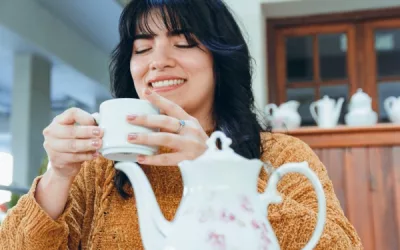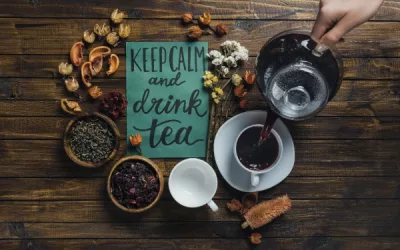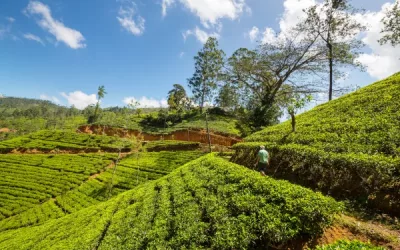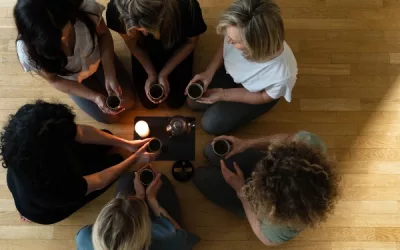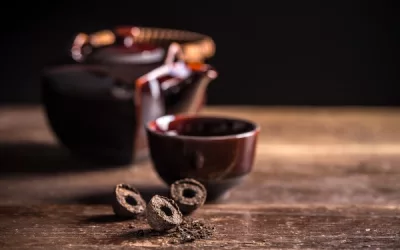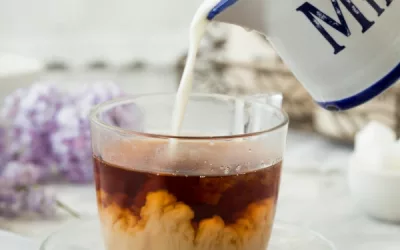Have you ever pondered why tea holds such a revered place in cultures worldwide? This seemingly simple beverage carries profound meanings and traditions that can enrich our understanding of language and social customs. From the ceremonial sips in Japan to the afternoon gatherings in Britain, tea transcends its role as just a drink. In this article, we will explore the diverse definitions, preparations, and cultural significance of tea, uncovering the layers that make it a vital part of global heritage.
Table of Content
- What is the definition of tea?
- How is tea prepared and consumed?
- What are the different types of tea?
- Can tea refer to a meal?
- What is the cultural significance of tea?
- How does tea influence social interactions in different cultures?
- What are some traditional tea ceremonies and their meanings?
- How has the globalization of tea affected cultural practices?
- What are common phrases or idioms that include tea?
- What does the phrase ‘spill the tea’ mean?
- How do idioms related to tea enhance language learning?
- Can you provide examples of tea-related phrases in literature?
- How do you say tea in other languages?
- What are the health benefits of drinking tea?
- Conclusion
What is the definition of tea?
Tea is a versatile term with several definitions depending on context. At its core, tea is a beverage made by steeping cured leaves of the Camellia sinensis plant. Besides the drink, in some regions, tea can also refer to a meal or social event.
Its preparation varies from simple boiling to intricate ceremonies. With its rich history, tea holds deep cultural significance, especially in countries like China, Japan, and the United Kingdom.
Knowing the different meanings and cultural nuances of tea can enrich one’s understanding and appreciation of this beloved drink.
Tea preparation involves steeping tea leaves in hot water, resulting in a fragrant, flavoured liquid. There are various types of tea, including black, green, oolong, white, and herbal infusions.
Each type has its unique characteristics and preparation methods. Tea’s cultural significance cannot be overstated. In Britain, it is a staple, often enjoyed with milk and sugar. In Japan, the tea ceremony is a revered practice.
Variations in tea’s meaning across regions and its use in idiomatic expressions highlight its wide-ranging influence on language and culture.
What are the primary definitions of tea?
Tea primarily refers to a beverage and sometimes to a meal or social event.
- Beverage: Tea is most commonly known as a drink made by steeping the leaves of the Camellia sinensis plant in hot water.
- Types of Tea: These include black tea, green tea, oolong tea, white tea, and herbal teas like chamomile or peppermint.
- Meal: In some British contexts, especially in northern England and Scotland, tea can mean an evening meal.
- Social Event: Afternoon tea, a British tradition, involves tea, sandwiches, and cakes served in the late afternoon.
Tea’s significance varies by region. For instance, in Britain, tea culture is profound, encompassing everything from casual tea breaks to formal afternoon tea. In Japan, tea ceremonies reflect deep cultural and spiritual practices.
The diversity in tea types and their preparation methods also adds layers to its meaning. Whether it’s a simple cup of green tea or a complex oolong, tea offers a sensory experience integral to many cultures.
How does the meaning of tea differ in British and American English?
The meaning of tea differs between British and American English in several ways:
- Meal Context: In British English, “tea” can refer to an evening meal, especially in northern regions.
- Social Event: “Afternoon tea” in British English is a specific event involving tea and light snacks.
- Beverage Preference: British people often drink black tea with milk, while Americans might prefer iced tea or herbal teas.
- Terminology: Americans generally use “dinner” for the evening meal, whereas some Brits might say “tea.”
Different terms and customs underscore regional tea preferences. In Britain, tea is synonymous with comfort and routine, integral to daily life. Americans, meanwhile, have a more diverse approach to tea, enjoying both hot and cold versions.
Understanding these differences can enhance cross-cultural communication and appreciation.
What are some common idioms that include the word tea?
Idioms featuring the word “tea” are common in English and add vibrant expression to conversations:
- Not my cup of tea: Not something one likes or enjoys.
- Tea and sympathy: Offering comfort and support.
- Tea for two: A cosy, intimate gathering.
- Tempest in a teapot: Making a big deal out of a minor issue.
- Take tea with: To meet or socialise with someone.
These idioms reflect tea’s embedded cultural significance. Using such phrases can make speech more colourful and relatable. They also offer insight into how deeply tea culture permeates language, making conversations richer and more nuanced.
In the 17th century, tea arrived in England through the East India Company. Initially, it was a luxury item, enjoyed by the elite. However, by the 19th century, tea had become a staple across all social classes.
Afternoon tea, a tradition popularised by Anna, the Duchess of Bedford, emerged during this period. She began inviting friends for an afternoon snack of tea and cakes, a practice that quickly caught on and became a beloved British institution.
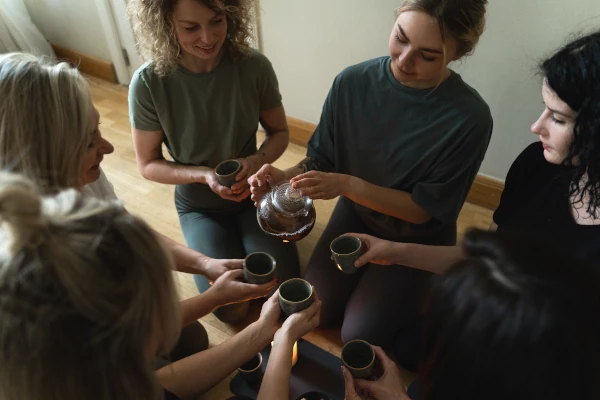
How is tea prepared and consumed?
Tea is one of the most popular beverages worldwide, cherished for its soothing properties and rich flavours. The preparation and consumption of tea can vary significantly depending on the type of tea and cultural practices.
Below, I’ve created a table to help you understand the diverse methods and traditions associated with different types of tea.
The table is organised into four columns: types of tea, preparation methods, serving suggestions, and cultural practices. This structure allows you to easily compare how different teas are made and enjoyed around the world.
Let’s dive in!
| Type of Tea | Preparation Method | Serving Suggestions | Cultural Practices |
|---|---|---|---|
| Green Tea | Steep 1-2 tsp of leaves in 80°C water for 2-3 minutes | Serve hot, without milk or sugar | Significant in Japanese tea ceremonies |
| Black Tea | Steep 1 tsp of leaves in boiling water for 3-5 minutes | Serve with milk, sugar, or lemon | Integral to British afternoon tea traditions |
| Oolong Tea | Steep 1-2 tsp of leaves in 85-90°C water for 4-7 minutes | Serve plain or with light snacks | Popular in Chinese tea culture, often served in Gongfu style |
| White Tea | Steep 1-2 tsp of leaves in 75-80°C water for 4-5 minutes | Serve hot, usually plain | Valued in Chinese traditions for its delicate flavour |
| Herbal Tea | Steep 1-2 tsp of herbs in boiling water for 5-10 minutes | Serve with honey or lemon | Used in various cultures for medicinal purposes |
| Masala Chai | Boil black tea leaves with milk, water, sugar, and spices like cardamom, cinnamon | Serve hot, often very sweet | Essential in Indian households and street vendors |
| Matcha Tea | Whisk 1-2 tsp of matcha powder with hot water until frothy | Serve hot, sometimes with sweets | Central to Japanese tea ceremonies |
| Rooibos Tea | Steep 1-2 tsp of leaves in boiling water for 5-7 minutes | Serve with milk and honey | Traditional in South African cultures |
How do you use and understand the table?
To make the most out of this table, follow these steps:
- Identify the Type of Tea: Look at the first column to choose the type of tea you’re interested in.
- Follow Preparation Methods: The second column provides specific details on how to prepare each type of tea.
- Consider Serving Suggestions: Get ideas from the third column on how to serve your tea for the best experience.
- Learn Cultural Practices: The final column shares the cultural significance and practices associated with each type of tea.
This structure ensures you grasp not only the technical aspects of tea preparation but also the cultural richness that accompanies it.
What are some unique tea types and their preparation?
There are several unique types of tea, each with its own preparation method and cultural significance. Here are some examples:
- Pu-erh Tea:
- Preparation: Steep compressed tea cakes in boiling water for 3-4 minutes.
- Serving: Serve hot, typically plain.
- Cultural Practice: Aged and fermented, used in traditional Chinese medicine.
- Yerba Mate:
- Preparation: Place yerba mate leaves in a gourd, add hot (not boiling) water.
- Serving: Drink through a metal straw called a “bombilla”.
- Cultural Practice: Common in South American countries like Argentina and Uruguay.
- Butter Tea (Po Cha):
- Preparation: Boil brick tea with water, add yak butter and salt, churn until mixed.
- Serving: Serve hot, often in small bowls.
- Cultural Practice: Staple in Tibetan culture, especially during harsh winters.
- Genmaicha:
- Preparation: Steep green tea with roasted brown rice in 80°C water for 2-3 minutes.
- Serving: Serve hot, usually plain.
- Cultural Practice: Popular in Japan for its nutty flavour and affordable price.
- Kombucha:
- Preparation: Ferment sweetened tea with a SCOBY (symbiotic culture of bacteria and yeast) for 7-10 days.
- Serving: Serve chilled, often flavoured with fruits or herbs.
- Cultural Practice: Known for its probiotic benefits, popular in health-conscious communities.
These unique teas showcase the diversity in preparation methods and the rich tapestry of cultural traditions surrounding tea consumption worldwide.
In ancient China, during the Tang Dynasty, tea became more than just a drink; it evolved into an art form. Lu Yu, known as the Sage of Tea, wrote “The Classic of Tea” (Cha Jing) around the 8th century.
This seminal work detailed the cultivation, preparation, and consumption of tea. Lu Yu’s meticulous efforts elevated tea drinking to a ceremonial act, influencing generations and spreading the practice across Asia.
His book emphasised the peaceful and meditative aspects of tea drinking, which led to the development of the Japanese tea ceremony.
I remember when I first tried making Matcha tea. I bought a small whisk and some ceremonial-grade matcha powder. The process of whisking the powder with hot water until it became frothy was almost therapeutic.
The first sip was a revelation—earthy, slightly sweet, and incredibly smooth. It felt like I was partaking in a centuries-old tradition, even in the comfort of my kitchen. That experience gave me a newfound appreciation for the cultural significance of tea rituals.
What are the different types of tea?
Let’s dive right into the lovely world of tea. Yes, the delightful beverage that can be classy and comforting all at once. We’re talking about tea in all its glorious forms – black, green, herbal, oolong, and white. There’s more to this drink than just being your grandma’s favourite afternoon pastime.
For starters, understanding the different types of tea can spice up your life, or at least make you a hit at the next fancy dinner party. And no, “tea bags” are not a type.
What distinguishes black tea from green tea?
Black and green tea are like chalk and cheese; they may come from the same plant (Camellia sinensis, if we’re getting technical), but they’re processed differently, giving them their unique flavours, aromas, and benefits.
- Oxidation: Black tea is fully oxidised, making it darker and richer. Green tea, on the other hand, skips this process, staying light and fresh.
- Caffeine Content: Black tea generally packs a caffeine punch, while green tea keeps things mellow with less caffeine.
- Flavour Profile: Black tea has a bold, malty, and slightly bitter taste. Green tea is subtle, earthy, and a tad grassy.
- Shelf Life: For you hoarders out there, black tea can be stored longer due to its oxidation. Green tea, however, prefers to be used quickly and isn’t a fan of over-staying its welcome.
- Health Effects: We’ll get into that in the next section, but trust me, both are beneficial in their own right.
What are the health benefits associated with different types of tea?
All tea enthusiasts know that the benefits of tea range from the subtle to the life-changing. Let’s break down what each type offers:
- Black Tea: Reduces blood pressure and lowers cholesterol levels. Helps in improving gut health and metabolism.
- Green Tea: Rich in antioxidants, it promotes heart health, aids in weight loss, and staves off brain aging.
- Herbal Tea: Not technically tea. It’s caffeine-free and varies in benefits: Chamomile for sleep, peppermint for digestion, and rooibos for skin health.
- Oolong Tea: A middle child between black and green tea, it boosts metabolism, improves mental alertness, and aids in fat reduction.
- White Tea: Delicate and less processed, it packs a punch with antioxidants, supports dental health, and provides antiviral benefits.
Each tea carries its own set of perks, but universally, these liquid wonders always make you feel better about life, even if it’s just by giving you a moment of zen in a crazy day.
How do cultural preferences influence the types of tea consumed?
Tea isn’t just a drink; it’s a cultural phenomenon that varies wildly around the globe.
- United Kingdom: A cup of black tea with a dash of milk and sugar can make any Brit feel at home.
- China: Green tea reigns supreme, symbolising purity and health.
- Japan: Think Matcha – the ceremonial powdered green tea with its unique preparation rituals.
- India: Masala Chai is a spicy, sweet concoction that wakes up your senses – and probably the whole neighbourhood.
- Middle East: Mint tea here is more than a beverage. It’s an emblem of hospitality.
Cultural preferences aren’t just random; they’re often rooted in history, climate, and local customs. They shape the type of tea that becomes popular in that region, influencing everything from farming practices to social interactions.
During the 17th century, tea smuggling was rife in England due to the skyrocketing taxes on tea imposed by the government. Tea was in such high demand that people just couldn’t get enough of it, legally or otherwise.
Smugglers used all sorts of tricks to sneak their prized packages into the country, even risking their lives. Some chests of tea would be hidden in barrels of animal fats or other exports. Eventually, the taxes were lowered, tea became more accessible, and the illegal trade dwindled.
But this historical drama highlights how deeply ingrained and treasured tea has been through the ages. So next time you sip your Earl Grey, remember – you’re part of a saga!
Can tea refer to a meal?
Absolutely, and if you’re now picturing a bunch of British folks dunking biscuits in their tea cups, you’re on the right track. But there’s more to it than that. In British culture, “tea” isn’t just about the drink; it also refers to specific meals and comes with enough variations and rules to perplex anyone who isn’t clued into the customs. Let’s break it down.
In the UK, “tea” can be a midday break, an elaborate event, or even an evening meal. Afternoon tea brings to mind delicate finger foods and a strong sense of etiquette, while high tea is more of a hearty affair often enjoyed by the working class, filled with substantial dishes that’ll more than just tickle your tastebuds.
What is the difference between afternoon tea and high tea?
So, here’s the lowdown: afternoon tea and high tea are distinct entities despite both sounding like plausible excuses for another cuppa.
Afternoon tea is all about finesse, elegance, and those finger sandwiches that make you feel like you’re at Buckingham Palace, even if you’re just in a swanky café:
- Timinig: Served around 3-4 PM.
- Setting: Extravagant, often in high-end tearooms or hotels.
- Menu: Delicate finger sandwiches, scones with clotted cream and jam, and assorted pastries.
- Beverages: Specialty teas, maybe a touch of Champagne if you’re feeling posh.
High tea is for when you need more than a snack to keep you going—think of it as the working man’s fancy tea that’s been beefed up to make sure you don’t faint from hunger:
- Timing: Served around 5-7 PM.
- Setting: Initially a working-class meal, now often enjoyed at home or in casual dining settings.
- Menu: Meat pies, cold cuts, cheese, boiled eggs, baked beans, and of course, tea.
- Beverages: Typically strong teas, but sometimes coffee or ale can pop up.
How has the tradition of tea as a meal evolved?
The tradition of tea as a meal has seen its own evolutionary tale, shaped by class divides, historical influences, and a dash of global cross-pollination.
- Origins: Afternoon tea was popularised in the 1840s by Anna, the Duchess of Bedford, to curb those stomach growls before dinner.
- Social Class: High tea, on the other hand, became a necessity for the working class who needed something substantial after a long day’s labour.
- Modern Twist: Fast-forward to today, afternoon tea has become a quintessential British experience, often served in luxurious settings.
- Global Spread: The concept has spread globally, morphing to suit local tastes, like Malaysia’s Malaysian Tea Time or Hong Kong’s Dim Sum Tea.
What foods are typically served during tea meals?
If there’s one thing you won’t run out of at a tea meal, it’s variety. Depending on whether you’re going for afternoon tea or high tea, your plate might look very different.
During afternoon tea, you can expect:
- Finger Sandwiches: With fillings like cucumber, smoked salmon, and egg and cress.
- Scones: Served with clotted cream and jam—don’t start the cream first or jam first debate here.
- Pastries: Delicate tarts, eclairs, macaroons.
- Cakes: Mini Victoria sponges, fruit cakes.
During high tea, the table’s offerings are heartier, featuring:
- Meat Pies: Steak and kidney, chicken and leek pie.
- Cheese and Crackers: Often accompanied by pickles.
- Cold Cuts: Ham, salami, and the like.
- Bread and Butter: Sometimes with a side of jam or marmalade for good measure.
Now, to throw in a delightful piece of history: did you know J. M. Barrie, the creator of Peter Pan, was known to host elaborate afternoon teas that could put to shame any high-end tearoom?
Apparently, he would invite guests over, serve a lavish spread complete with imaginative touches like fairy bread, and engage them in whimsical conversations. This tradition mirrored the playful and fantastical world he created in his writings.
If you fancy a bit of Neverland mixed with your tea, perhaps it’s time to sprinkle a tad of imagination into your next tea-time ritual.
What is the cultural significance of tea?
Tea isn’t just a drink; it’s woven into the fabric of many cultures around the globe. You can’t swing a cat without hitting a culture that thinks tea-time is sacred. Let’s break it down.
Let’s face it, tea is the social butterfly of beverages. It doesn’t just sit quietly in a cup; it wants to make friends and influence people. Tea brings folks together, often acting as the social glue for all kinds of gatherings.
- Japan: Think “Zen” and “mindfulness”. The Japanese tea ceremony, or ‘chanoyu’, is all about calm, grace, and ritualistic precision. It’s a way of bringing people together in a meditative environment.
- Britain: Ah, the British! For them, tea is practically a religion. The afternoon tea tradition—with its scones, clotted cream, and finger sandwiches—is an opportunity for refined chit-chat. Think Downton Abbey, but with fewer corsets.
- China: Tea is deeply embedded in Chinese culture. It’s seen as a symbol of harmony, purification, and wisdom. Offering tea is a gesture of respect and is a staple in social and even business interactions.
- India: Walk down an Indian street, and you’re bound to encounter ‘chai wallahs’ brewing up a storm. Tea stalls are social hubs where everything from politics to cricket is debated over a hot cup of masala chai.
Growing up, you must have noticed how a mere invitation for tea can signify “let’s talk”, “let’s mend fences”, or “let’s just enjoy each other’s company”. No wonder ancient folks seemed to get along better—they had their priorities straight with tea making the rounds.
What are some traditional tea ceremonies and their meanings?
Traditional tea ceremonies can seem mystical and bewildering, like watching a magician pulling a rabbit out of a hat, only classier. Here’s a sneak peek into a few famous ones:
- Japanese Tea Ceremony (Chanoyu): Involves artistic preparation, mindfulness, and careful consideration of each step. Everything, from the utensils to the tea room, is meticulous.
- Chinese Gongfu Tea Ceremony: This involves a series of rinsing, pouring, and timing techniques that bring out the full flavour of the tea leaves. It’s like alchemy, but for tea.
- British Afternoon Tea: A mid-afternoon indulgence of light snacks and tea, aiming at sophistication and social interaction. It’s not just tea; it’s a mini-meal.
- Moroccan Mint Tea Ceremony: Served traditionally in three rounds, each serving getting progressively sweeter. It symbolises hospitality and friendship.
These tea ceremonies aren’t just about sipping hot beverages; they reflect discipline, tradition, and community spirit. It’s like turning a simple act into an art form, with a side of zen and a dash of etiquette.
- Indian Chai Rituals: Brewing and serving chai is an everyday affair but rich in ritual. It’s all about adding spices like ginger and cardamom, simmering for the perfect flavour.
When you take part in these ceremonies, you’re not just drinking tea; you’re diving into a cultural experience that dates back centuries.
How has the globalization of tea affected cultural practices?
Tea’s globetrotting adventures have led to some fascinating blends (pun intended) of cultural practices. It’s as if tea decided to take a world tour and picked up a bit of flair from everywhere.
- Fusion Teas: Matcha lattes, Chai tea lattes—who thought of these concoctions? Globalisation, that’s who. It’s led to cross-cultural blends that mix the east’s traditional flavours with the west’s coffee culture.
- Cultural Adaptation: Traditional tea practices adapt to fit more modern or cross-cultural environments, making rituals accessible to a wider audience.
- Health Craze: With the rise of health consciousness, various herbal and green teas are being adopted globally, often touted as miracles in a cup.
- Economic Impact: The global tea trade has influenced economies, driving cultivation and tourism in tea-producing countries like India, China, and Kenya.
But hey, it’s not all about Spiced Pumpkin Chai Lattes, okay? While globalisation has mixed things up, it’s also shown how tea rituals can adapt and survive. It’s like they took the best bits from everywhere and made them their own.
In the late 19th century, the British Empire had a significant influence on the globalisation of tea. The British Raj in India saw the establishment of vast tea plantations in Assam and Darjeeling.
One notable incident is the Boston Tea Party of 1773, where American colonists, frustrated with British tea taxes, dumped an entire shipment of tea into the Boston Harbour. This act of rebellion paved the way for American independence and marked tea as not just a commodity, but a catalyst for change.
This historical drama shows that tea’s influence goes beyond the teapot, impacting even political landscapes.
What are common phrases or idioms that include tea?
Ah, tea. A humble beverage with a global footprint. But we’re not here to discuss its flavour profile or the best tea brands. We’re diving into the rich lexicon of tea-related phrases. Let’s spill some beans—wait, no—some tea on this subject.
From idioms that make you sound like a sophisticated Anglophile to slang that keeps you hip with the younger crowd, tea has infused itself into our language in remarkable ways.
First off, let’s tackle the origin bit. These phrases mostly sprout from societies where tea drinking is a social staple—from the United Kingdom to China. For instance, ‘not for all the tea in China’ hails from a time when China was the top tea exporter in the world.
The underlying sentiment? There’s no way, under any circumstances.
Now, when it comes to meanings and usage, it gets even more fascinating. These idioms inject colour into conversations, adding that zing which plain words often fail to deliver. Using them will not just spice up your dialogue but can also demonstrate your cultural and linguistic prowess.
What does the phrase ‘spill the tea’ mean?
Brace yourself because this one is juicy. When you hear someone say, “spill the tea,” it’s not an invitation to ruin a perfectly good beverage by pouring it out. Nope, it’s slang for sharing gossip or revealing secrets. Picture a group of friends gathered around, waiting for the latest scoop.
They aren’t sitting with anticipation for a tea party; they’re salivating for the gossip.
- Origin: Rooted in African American Vernacular English (AAVE), it gained mainstream popularity through drag culture, notably popularised by reality shows like ‘RuPaul’s Drag Race’.
- Usage: Often appears in both casual and online conversations.
- Context: Whether discussing celebs or your neighbour’s antics, the phrase is a dynamic way to demand or convey the latest info.
- Similar Terms: Spill, dish, drop a bombshell.
- Attributes: Informal, modern, and trendy.
So next time someone says, “Spill the tea,” you better be ready to share some tantalising tidbit.
Tea idioms aren’t just linguistic fluff; they’re functional linguistic tools. They enhance your language skills by making your expressions more vivid and culturally relevant. Ever wondered why language learners are encouraged to use idioms?
They bridge the gap between textbook learning and real-life conversations.
- Cultural Insight: Idioms provide a window into cultural norms and values.
- Engagement: They make dialogues more engaging and less robotic.
- Comprehension: Learning idioms aids in understanding contextual meanings rather than literal interpretations.
- Fluency: Frequent use can improve conversational fluency.
- Memory: Associating phrases with vivid imagery can make them easier to remember.
Incorporating tea idioms can be especially enriching if you’re delving into English language studies. It adds a layer of depth that simple grammar exercises can seldom achieve.
Tea is not just a beverage; it’s a muse for many a literary figure. Its presence in literature often symbolises more than just a drink; it’s an experience, a tradition, and a milieu. Charles Dickens, for instance, didn’t shy away from his affection for tea. And Jane Austen practically made it a character in her novels.
- “A tempest in a teapot”: Mark Twain loved this one, using it to describe a lot of fuss over something trivial.
- “Tea and sympathy”: A phrase that’s appeared in numerous works, representing comfort and emotional support over a cup of tea.
- “Not for all the tea in China”: Found in British literature to signify an impossible deal.
- “It’s my cup of tea”: Used extensively to describe something one prefers.
These examples aren’t just literary fluff. They connect you with a broader socio-cultural narrative, enriching your understanding of context and history.
Speaking of enriching narratives, ever heard about the Boston Tea Party in 1773? A historic event where American colonists, frustrated with British taxes, dumped an entire shipment of tea into the Boston Harbour.
This wasn’t just a protest; it was a pivotal moment leading to the American Revolution. It showed how a simple beverage could become a symbol of resistance and rebellion, echoing through the annals of history.
So, the next time you pour yourself a cup of tea, remember—you’re not just sipping a beverage; you’re partaking in centuries of culture, rebellion, and, of course, some delightful idioms. Cheers!
How do you say tea in other languages?
Tea. It’s that magic potion that can start your morning on a high note or soothe you after a long day. But guess what? This little leaf has a passport with far more stamps than you and I combined. Let’s dive into how we refer to this beloved drink across the globe and why it’s so much more than just a beverage.
Tea, pronounced differently around the world, reflects the uniqueness of each culture. It’s called “cha” in one place and “chai” in another. It holds ceremonial importance in Japan’s tea ceremonies or is merely a daily ritual everywhere in England.
Understanding this can broaden your perspective and maybe even impress your next conversational sparring partner.
What is the word for tea in Spanish, French, and Mandarin?
- SPANISH: In the land of flamenco and tapas, Spaniards call it “té” (pronounced like “tay”). Pretty simple, right?
- FRENCH: Over in the country of cheese and the Eiffel Tower, the French elegantly say “thé” (pronounced “tay”). Très chic!
- MANDARIN: Now, things get a bit trickier. In Mandarin Chinese, it’s “茶” (chá). And no, you don’t need to know kung fu to pronounce it—just a little practice!
Cultural Significance:
- In China, tea isn’t just a drink; it’s an art form filled with historical symbolism.
- In Spain, it’s often enjoyed but doesn’t quite steal the spotlight from coffee.
- France has its sophisticated tea salons where sipping a cup can make you feel like the French royalty.
How do cultural differences affect the perception of tea?
Tea isn’t just about the liquid in your cup; it’s a cultural tapestry woven with history and social customs. In the UK, tea is practically an institution—think “afternoon tea” with scones and dainty sandwiches. Meanwhile, in Morocco, tea-drinking is a sign of hospitality, usually served gloriously sweet and minty.
Tea’s Cultural Hat Collection:
- Japan: Tea ceremonies that celebrate nature, simplicity, and mindfulness.
- Russia: Samovars boiling away to serve black tea with lemon and pastries.
- India: “Chai” spiced with cardamom, ginger, and loads of sugar, sold on almost every street corner.
Such cultural contrasts make tea fascinating. It shows how a simple leaf can adapt and influence societies worldwide, offering a peek into local lifestyles and traditions.
What are some interesting facts about tea in non-English speaking countries?
Buckle up, tea nerds, here are some surprising tidbits:
- Argentina: Sip on yerba mate, a tea-like drink sipped from a hollowed-out gourd through a metal straw. It’s practically a social necessity.
- Tibet: Butter tea anyone? Yep, they mix tea with yak butter and salt. It’s not everyone’s cup of… well, you know.
- Turkey: Not your English breakfast kind! They brew their strong çay (pronounced “chai”) in special double teapots.
Fun-Fact List:
- Spaniards celebrate with “té” but only occasionally compared to their fervour for “café”.
- The French drink less tea than the British but have a rich tradition of herbal “tisanes”.
- In China, there’s a tea that grows in panda poo. Yep, you heard that right. It’s a thing.
These facts highlight not only the diversity of tea but also the boundless creativity cultures bring to this common element of daily life.
Once upon a time, in 16th-century Russia, Tsar Michael I received tea as a diplomatic gift from China. The Russians were initially puzzled by these “exotic leaves”, unsure what to do with them.
After a bit of experimentation and some guidance from Chinese emissaries, tea became a staple. They even developed their own samovar—a unique tea-brewing apparatus that kept tea warm for hours.
Today, no Russian household is complete without one.
So next time you sip your tea, remember you’re participating in a historic, global ritual. Enjoy it, because tea isn’t just a drink—it’s a world full of stories waiting to be discovered.
What are the health benefits of drinking tea?
Alright, let’s talk about tea – that marvellous elixir that fixes your soul on a rainy day and comes with a horde of health benefits. Sipping on tea isn’t just about feeling fancy with a pinky up; it stands tall with some legitimate perks for your wellbeing.
In this tea-riddled journey, we’ll dive into the goodness-packed antioxidants in tea, chat about how it can be your sidekick in leading a healthy lifestyle, and – because every silver lining has a cloud – discuss if too much of this liquid gold can have any downsides.
What are the primary antioxidants found in tea?
Let’s take on the stars of the tea world – the antioxidants. SIP and savour these powerhouses:
- Catechins: Mainly found in green tea, these bad boys are like the ninjas of antioxidants; they nimbly fight off those pesky free radicals.
- Theaflavins: Black tea boasts these gems. They’re known for protecting your heart and maybe even aiding in weight loss.
- Flavonoids: These are found in various teas and work wonders for heart health. Think of them as tiny heart protectors in your cup.
- Polyphenols: These compounds are practically everywhere in tea and are the ultimate guardians against cell damage.
Now, on to the fun part – understanding the nitty-gritty of these antioxidant superheroes.
How can tea contribute to a healthy lifestyle?
Tea can definitely be more than just a beverage; it’s a lifestyle ally. Here’s how:
- Boosting Metabolism: Green tea is the secret weapon many swear by to increase metabolism and inch closer to shedding those extra pounds.
- Keeping the Heart Happy: With flavonoids and theaflavins, your heart gets a friend that helps lower blood pressure and reduce cholesterol.
- Aiding Digestion: Herbal teas like peppermint or ginger are like digestive wizards, helping you combat bloating and keep the gut happy.
- Calming the Mind: Theanine in tea brings a sense of calm and zen, making your headspace a serene place to reside.
On top of all that goodness, imagine having a ritual that centres you, whether it’s your morning kick-start or evening wind-down.
Are there any health risks associated with excessive tea consumption?
Too much of a good thing can indeed be bad, and tea isn’t spared. Here’s why:
- Caffeine Overload: Over-consuming caffeinated tea can lead to jitters, insomnia, and even caffeine dependence. You don’t want to turn into a night owl with bags under your eyes.
- Iron Absorption: Drinking buckets of tea can impair your body’s ability to absorb iron from food. Let’s avoid that pale, weak look, shall we?
- Dental Stains: The rich tannins in your beloved tea can invite stains on your pearly whites, making you think twice before that selfie.
- Kidney Health: Excessive black tea can lead to an overload of oxalates, potentially causing kidney stones. Not the kind of rock you’d like to collect.
Balance is key, folks! Keep your tea habit enjoyable and safe by sticking to a moderate intake.
One famous tea-drinker who appreciated the art of moderation was George Orwell. Not only did Orwell pen down his profound thoughts in “1984,” but he was also a tea connoisseur, even writing an essay titled “A Nice Cup of Tea.”
In it, he detailed his 11 golden rules for the perfect cup, valuing quality over quantity. This legendary writer found solace and inspiration in his daily tea ritual, striking the perfect balance for long hours of literary brilliance.
Remembering Orwell reminds us to enjoy tea as an enriching part of life, but without letting it steep into excess.
Conclusion
In reflecting on the multifaceted meaning of tea within various cultural and linguistic contexts, I find myself appreciating just how deeply this humble beverage intertwines with our daily lives. Throughout this exploration, we have uncovered that tea is not merely a drink; it encompasses a rich tapestry of customs, rituals, and social interactions.
From its diverse preparation methods and types—like the refreshing green tea to the robust black tea—to its role as a meal during afternoon tea in British culture, tea conveys differing nuances across regions and societies.
The importance of understanding these nuances cannot be understated. A cup of tea brings us together, bridging gaps between cultures and generations while fostering connections through shared traditions.
The idioms and phrases that incorporate tea add depth to our language, enhancing our communication as language learners and cultural enthusiasts. Just think of how comforting the phrase “spill the tea” feels, inviting conversation and intimacy.
As I conclude, it becomes clear that my journey through the world of tea has only just scratched the surface. There remains an opportunity for deeper investigation into local customs and health benefits associated with this beloved drink.
So, I invite you, dear reader, to ponder this: how can something as simple as tea influence our interactions, our health, and even our understanding of one another? Perhaps we can take a cue from global tea practices to enhance our own approach to hospitality and community engagement; after all, good tea offers us not just warmth, but also a chance to forge connections that transcend cultural boundaries. Wouldn’t it be wonderful to raise a cup and embrace the warmth of unity that tea encourages?
Resources
- Health Benefits of Tea – Herbal Medicine
- Antioxidant mechanism of tea polyphenols and its impact on health benefits
- Tea consumption and the risks of all-cause, cardiovascular disease, and cancer
- Antioxidant effects of tea: evidence from human clinical trials
- Molecular mechanisms underlying health benefits of tea compounds
- Herbal Teas and their Health Benefits: A Scoping Review


